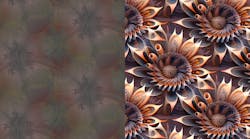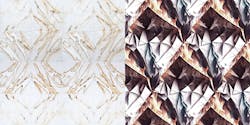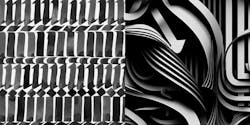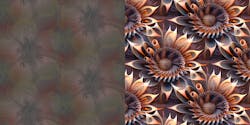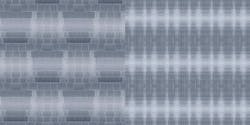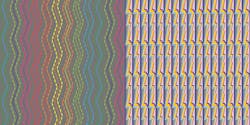Wolf-Gordon Introduces Conceptual Project: Human-Generated vs. AI-Generated Design
Wolf-Gordon has introduced its latest concept-driven collection of digitally printed PVC-free wallcoverings, “Project: HI > AI,” a timely snapshot of the meeting of human intelligence and artificial intelligence. Curator and chief creative officer Marybeth Shaw invited seven creatives to develop original patterns. The artists then submitted verbal descriptions of their work that were subsequently input into AI imaging software and, in most cases, edited by Shaw and Michael Loughlin, Wolf-Gordon design director, to achieve a more relevant approximation or contrast with the original art.
Ranging from printmakers to conceptual artists, art jewelers to sign painters, the artists represent diverse media, cultural backgrounds and geographies: Hilary Lorenz, print media artist, Abiquiu, NM; Raylene Marasco, textile artist and founder, Dyenamix, NYC; Jen Mussari, calligrapher and sign painter, Brooklyn; Pat Pruitt, metalsmith, Ada, OK; Christine Tarkowski, artist and professor, SAIC, Chicago; Frank Tjepkema, designer and founder, Tjep, Amsterdam; Ghislaine Vinas, interior designer, NYC.
Shaw took the song “Human Behavior” by Bjork (written from the perspective of an animal observing humans) and suggested for the participants that with “Project: HI > AI”, humans might be replacing the animal with a machine. Each creative explored diverse themes such as the process of making, the uniqueness of human-generated art, and anxiety over impinging technology, surveillance and control in our lives. Although the AI software could not match the human’s creations, the results are remarkable for their range of interpretation which goes from an otherworldly take on organic and traditional motifs to hand-drawn and -painted compositions, as well as multi-step art-making processes.
Patterns
Famossa, an abstracted, pointillist floral motif by designer Frank Tjepkema, was created on CAD software with a lengthy list of words that yielded a better result when edited down. “Magnetic field, organic, floral, parametric,” output a fantastical, alien flower that one might encounter on Naboo (Queen Amidala’s planet).
Furrows, designed and hand-painted by textile artist Raylene Marasco, required rearranging of the original prompt and additional cues like “brick-like layout” and “soft grey color.” While less nuanced than Marasco’s painting, which she executed by dragging pigment down an unevenly hand-dyed fabric with vintage metal graining comb, its AI counterpart is a complex light-infused pattern that resembles a high-tech ikat.
Playful Toile, by designer Ghislaine Viñas, explores a tableau of human-inflicted adversities existing in a developing or, controversially, collapsing world. The pattern is a mash-up of misfortunes with surveillance as a key theme, under the guise of a perfectly pleasing pattern. The traditional wallpaper pattern output by AI couldn’t match the degree of threat designed by Viñas.
Beyond the possibility of utilizing AI imaging software in commercial pattern design and the crucial role of language in the translation of imagery, the exhibition highlights what Shaw refers to as the rupture in viewing AI-generated art.
“Project: HI > AI” will be on display in Wolf-Gordon’s headquarters, 333 Seventh Avenue, New York through the end of December 2023. All seven human-generated patterns will be available through Wolf-Gordon’s Curated Collection.
